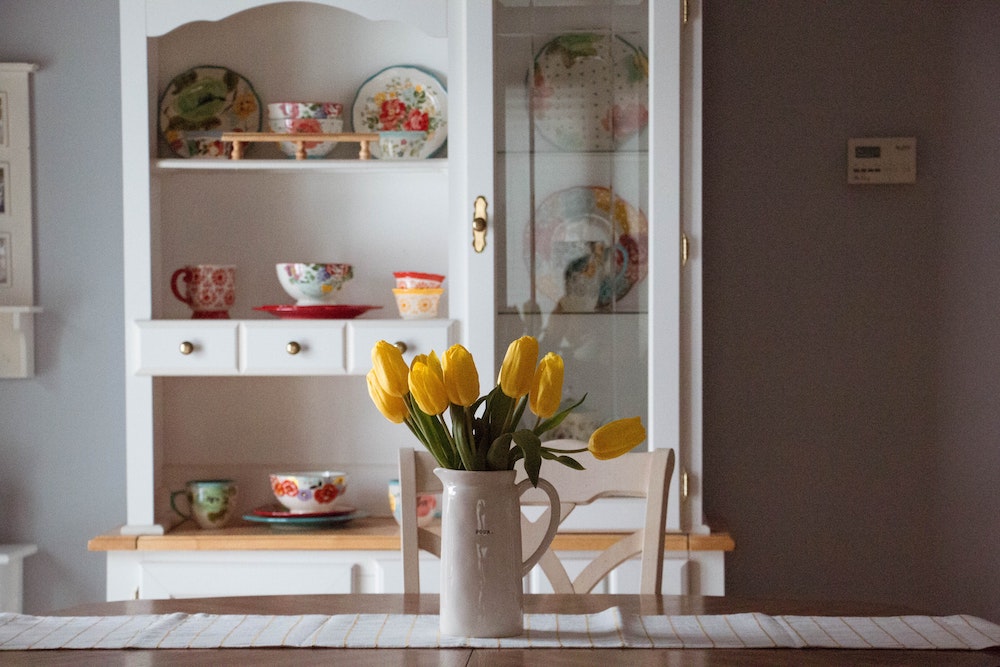Keeping things nice and clean is an important part of good home maintenance. If you’re an enthusiastic antique collector or you’ve recently received an inherited piece of furniture from your parents or grandparents, it’s important to know how to clean a variety of surfaces and materials properly. When you know how to clean metal, wood, and stone the right way, you can restore antique furniture and other items back to their full glory. Read on to learn how to clean virtually any surface in your home without causing damage so that you can enjoy your beautiful antiques and special furniture for years to come.
Identify Your Antiques
In order to keep your antique items clean, you’ll need to start by figuring out exactly what you have. Examine the item closely to determine what type of metal, wood, stone, or even a vintage engagement ring. This also applies to antique fabrics and area rugs. Whether it’s silk, wool, or some other material, knowing what you’re working with will make it easier to clean the correct way, since not all materials are cleaned in the same manner.
To start, identify antique items in your home and determine what they’re made of. Do some online research to find the era, maker, and material of each piece. Catalog each piece, its materials, and how to clean it for future reference. Many homeowners have items around the house that are valuable antiques, and they may not even know it!
- In the kitchen, look for vintage silverware, dishes, crystal, and china sets.
- In the bedroom, examine old chairs, dressers, bed stands, and mirrors.
- All around the house, look at accent pieces like tables, chairs, and benches.
- Check your lamps, books, and bric-a-brac.
Materials that Can be Cleaned with Common Household Products
Some antiques can easily be cleaned using products you already have at home. You can also make your own organic cleaners that don’t contain any harsh chemicals, which may also help to prevent damage to your furniture. Here’s how you can safely clean and/or update most antiques — but do your research, because sometimes, stripping, painting, reupholstering, or making other modifications can significantly reduce the value of some pieces.
- First, look for signs of pests like termites and furniture beetles that could chew up old wooden furniture. Gently shake the furniture and open drawers to confirm that there are no animal nests inside. Look for small holes and urine smells, and examine the entire piece from top to bottom, as well as underneath to make sure that there’s nothing hiding and that no pests will end up infesting your home.
- Clean your furniture with a soft, dry cloth to remove dust and debris.
- Use a microfiber cloth dampened with warm water and a mild household to remove grime from wood, glass, metal, and stone.
- Scrub away the grime in crevices and corners with a soft-bristle toothbrush.
- If your wood or metal furniture is covered in layers of paint or flaky finishes, use sandpaper to remove it. Sanding the furniture will restore it to its natural state, and you can apply a new finish.
- As you’re working, consider using some DIY techniques that will give antique furniture new life, like reupholstering a set of old dining chairs, stripping and staining an old wood dresser, or turning a large, old headboard into a chalkboard with chalk paint.
Furniture that Requires Special Handling
Some materials may require that you use specialized cleaning chemicals, or even hazardous materials to remove rust or old layers of paint. It’s up to you to decide whether this method is worth it or whether it’s best to leave the furniture as-is.
- Take your antique item to a restoration specialist if it’s extremely old, rare, or valuable since DIY cleaning can permanently damage it.
- Remove rust from metals like iron or stainless steel with calcium, lime, and rust-removing product.
- Shine silver or brass by rubbing it gently with a slice of cucumber to gently and naturally lift the tarnish away. You can also make a DIY solution of baking soda, water, and lemon to help restore these types of metal to their original brilliant shine.
- Clean metals like copper, gold, silver, and aluminum with organic or natural cleaners. Avoid using chemicals on these types of metals whenever possible, as they could damage the finish.
- Apply a coat of wax to restore shine to wood furniture. Beeswax has been used for centuries, but it can leave a sticky film on your furniture. Try carnauba wax if you want to restore the shine on original hardwood floors. For antique and vintage wood furniture, the best type of wax to use is mineral-based wax, since it won’t damage the original finish on older pieces.
Stain Removers and Repair Techniques for Wood, Metal, and Fabrics
Stubborn stains and scratches can affect the beauty and integrity of your antiques. Here are some tips to help you remove stains and repair scratches the right way:
- A simple mixture of gentle soap and water typically does a good job of removing stains from wood. If you end up with tougher grime, try some oil soap (you can find it at most home improvement stores) and a soft cloth to gently wipe the mark or stain away.
- To remove rust from metal, start by gently sanding it off with low-grit sandpaper. If the rust remains, use gentle yet effective rust removing products. It’s best to do a spot test in an inconspicuous area first just in case the cleaner causes any damage or leaves a mark behind.
- Use a wood filler to repair scratches and gouges in wood furniture. Make sure you choose the right color, so it matches as closely to the original as possible. Clean the scratched area with a dry cloth, then apply the wood filler until it’s filled in all the way. You can also use iodine, a colored furniture polish, or even instant coffee (depending on the color of the furniture).
- To remove scratches from metal, try some vinegar or a powdered scratch removing product if the scratch is minimal. For deeper scratches, you’ll need to sand the area first, then polish it thoroughly to restore it and make it look new again.
- Clean antique fabrics, such as hats or other types of fabrics with a mixture of gentle soap and warm water. Hand washing most fabrics should do the trick. If you still can’t get the stain to come out, consider taking the item to a professional, but never wash it in the washing machine, as it could permanently damage the fabric.
How to Store and Display Your Antiques to Prevent Damage
Taking good care of your antiques will preserve the integrity of your furniture and other valuables. Part of that is making sure you’re storing and displaying everything the right way. With the right storage methods, you’ll be able to preserve these priceless items so they can continue to be passed down to future generations.
- Store delicate items and breakables in a storage cabinet with a door. The door will keep everything protected from dust and dirt so that it remains clean and well-preserved. Keep in mind that moving your antique needs proper knowledge and skills.
- Keep antique wood furniture out of direct sunlight at all times. The UV rays from the sun can cause discoloration and dry out the wood, which can result in warped or cracked pieces.
- Apply a quality wood oil treatment to unfinished wood furniture at least once a year to keep it protected. For finished furniture, dust it regularly and apply a color-safe wood cleaner or furniture polish as needed.
- Store your antiques in a part of the home that has a reasonable humidity level between the recommended 30 and 50 percent. Rooms that are too humid or too dry can cause furniture to expand and contract, which may cause in cracks and splinters.
- Apply a protective coat to vintage textiles and fabrics to help prevent stains. Make sure you use the correct product based on whether the fabric is made for interior or exterior use (such as an antique outdoor area rug). Never wash vintage fabric in the washing machine, and avoid using cleaners that contain harsh chemicals. You can also try and search for the best vintage furniture stores and ask for care information, they are experts on this.
Proper Antique Restoration and Care: Avoiding Mistakes
If you don’t know how to restore and care for antiques properly, it can lead to some pretty upsetting results.
- If you take your antique to a professional restorer, make sure that you’re clear about what you expect. Some antique restorers might refinish that old chest you love rather than just clean it up, which can lead to disappointment.
- Never use a cleaning product on antique surfaces unless you’re positive they will not cause permanent damage or discoloration. A good rule of thumb is to try DIY organic cleaners whenever possible since chemicals can cause all kinds of problems. Test the cleaner on an inconspicuous section of the piece.
- Avoid getting wood furniture too wet, or it may warp or swell. Always use the minimum amount of water needed to clean it up.
- Unless you plan to recycle or upcycle old furniture, it’s best to simply clean it up and let its original beauty shine. Refinishing will completely change the piece — and may negatively affect the value.
Once you know how to clean and care for your antiques, vintage jewelry, and antique furniture, you’ll be able to keep them in good shape for another hundred years or more. Know when to DIY and when to hire a professional to handle the task. With these tips in mind, you can start to clean and maintain your antique furniture with confidence.
Safeguarding Your Antiques with Home Insurance
Preserving and protecting your treasured antiques goes beyond their physical care. Understanding how your home insurance policy can offer a safety net for these valuable items is crucial. While insurance coverage for antiques might vary, it’s essential to explore potential inclusions and limitations within your policy to ensure adequate protection.
Antique Coverage in Home Insurance
- Valuation and Coverage: Evaluate whether your current home insurance policy adequately covers the full value of your antiques. Some policies might have limitations or exclusions regarding high-value items.
- Scheduled Personal Property: Consider adding a scheduled personal property endorsement or a separate rider to your policy to specifically cover high-value antiques. This tailored coverage ensures these items are protected against a wider range of perils and typically offers higher coverage limits.
Appraisal and Documentation
- Professional Appraisal: Get your valuable antiques professionally appraised to establish their current market value. Document these appraisals and keep detailed records, including photographs, receipts, and any other relevant information that can support your insurance claims.
- Regular Valuation Updates: As the value of antiques might fluctuate over time, consider updating the appraisals and insurance coverage regularly to reflect any changes in their value.
Policy Limitations and Exclusions
- Understanding Coverage Limitations: Review your insurance policy to understand limitations and exclusions related to antiques. Some policies might restrict coverage for certain types of damage or loss.
- Specialized Coverage Needs: Be aware of any special conditions or requirements for specific types of antiques, such as fine art, jewelry, or rare collectibles. Tailor your policy to accommodate these unique items.
Loss Prevention and Risk Mitigation
- Secure Storage and Display: Safeguard your antiques by storing them in secure cabinets or display cases to protect them from dust, direct sunlight, and potential damage. Proper storage methods can prevent accidents and minimize risks.
- Preventative Maintenance: Regularly maintain and care for your antiques to prevent deterioration. By keeping them in good condition, you reduce the likelihood of damage and the need for potential insurance claims.
Insurance Consultation and Review
- Discuss Coverage Needs: Consult with your insurance provider to discuss the specific needs and risks associated with your collection of antiques. Seek guidance on adjusting or supplementing your policy to ensure adequate coverage.
- Policy Amendments: Based on your discussion with the insurer, consider any recommended policy amendments or additions to better protect your valuable antiques.
Safeguarding your valuable antiques involves both physical care and insurance protection. Understanding the specifics of your home insurance policy, along with its coverage for antiques, is critical for ensuring comprehensive protection. Regularly assessing the coverage, documenting the items, and discussing your needs with the insurer can help secure appropriate coverage for your treasured possessions. By taking proactive measures and aligning your insurance coverage accordingly, you can minimize risks and enjoy your valuable antiques with confidence. Always seek professional advice and guidance when it comes to insuring your high-value antiques to ensure they are adequately protected.




